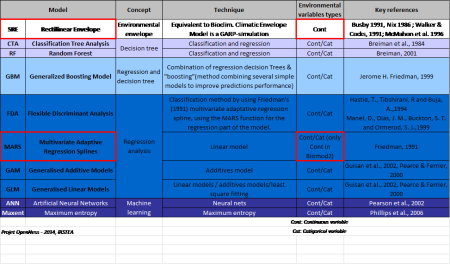Image:

Resource description:
Species distribution models (SDMs) (Franklin, 2009) have shown great potential in helping to achieve conservation planning goals by refining our knowledge of species distributions (Jetz et al., 2012). SDMs extrapolate species distribution data in space and time, usually based on a statistical model. These models identify areas that are ecologically suitable for the presence of species (Soberon & Peterson, 2005; Hirzel et al., 2002; Franklin, 2009).
Author/Contact:
Dr Paula Harrison,
Land Use Group,
Centre for Ecology and Hydrology,
Lancaster Environment Centre,
Library Avenue,
Bailrigg,
Lancs,
LA1 4AP
+44 (0) 1524 595858
Publication date:
Images
Requirements:
- Appropriate species and contextual (or proxy) datasets for the case study area.
- In general, SDMs require expertise from the ecology/biodiversity field, but input from non-academic stakeholders can be useful to validate the results
- Availability of software depends on the species distribution model in question. Some software is freely available for download, others are embedded in particular institutions. BIOMOD is implemented in R statistical coding landuage and is a freeware, open
Advantages:
- Can identify areas where climate and/or habitat is appropriate for a given species
- Can be used to explore multiple future scenarios
- Spatial outputs produced with accompanying goodness-of-fit statistics.
Constraints:
- Some species are very hard to model as the factors driving their present-day distributions are unclear. The projections generally reflect the climate, environmental characterisitics and/or habitat niche that a species could potentially use - they do not
- As with any modelling, some species fit better with the driving variables and produce projections that are more statistically significant than others
- Relatively advanced statistical process underly the models
Licence:
- Free, no licence
Development stage:
- Full, working product
Resource link:
Resource download:
- methodfactsheetsdms.pdf (665.78 KB)
